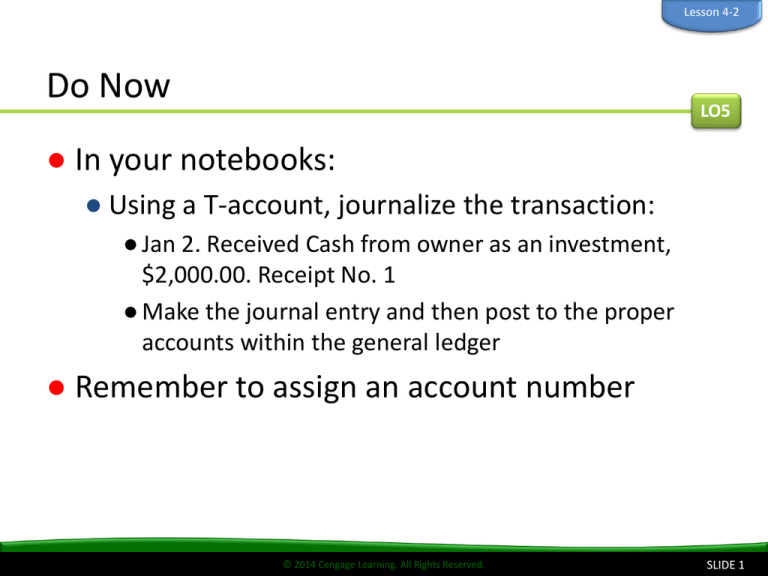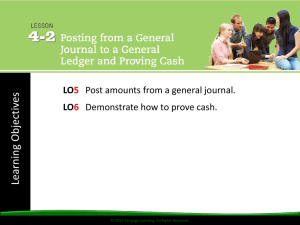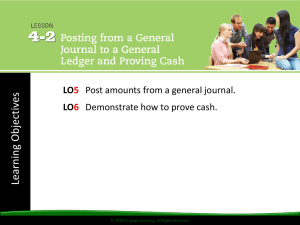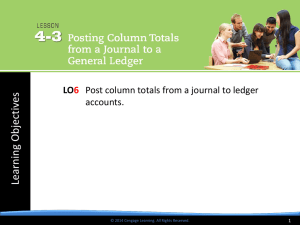
Lesson 4-2
Do Now
LO5
● In your notebooks:
● Using a T-account, journalize the transaction:
● Jan 2. Received Cash from owner as an investment,
$2,000.00. Receipt No. 1
● Make the journal entry and then post to the proper
accounts within the general ledger
● Remember to assign an account number
© 2014 Cengage Learning. All Rights Reserved.
SLIDE 1
Lesson 4-2
Posting an Amount from the Debit
Column of a General Journal
LO5
● Transferring information from a journal entry
to a ledger account is called posting.
● Posting sorts journal entries so that all debits
and credits affecting each account are brought
together
● Each amount in the debit and credit columns
of a general journal is posted to account
written in the Account Title Column
© 2014 Cengage Learning. All Rights Reserved.
SLIDE 2
Lesson 4-2
Posting an Amount from the Debit
Column of a General Journal
LO5
● Numbers in Post Ref. columns of general ledger
account and general journal serve three
purposes:
1. Entry in account can be traced to source in journal
2. Entry in journal can be traced to where it was posted
in an account
3. If posting was interrupted, the accounting personnel
can see which entries in the general journal still
need to be posted
●
blank in the Post Ref. column of the journal means that
posting for that line still needs to be completed (that’s why
it’s the last step)
© 2014 Cengage Learning. All Rights Reserved.
SLIDE 3
Lesson 4-2
Posting an Amount from the Debit
Column of a General Journal
LO5
2
1
3
5
4
1. Write the date.
2. Write the journal page number.
3. Write the debit amount.
4. Write the new account balance.
5. Return to the journal and write
the account number.
© 2014 Cengage Learning. All Rights Reserved.
SLIDE 4
Lesson 4-2
Posting an Amount from the Credit
Column of a General Journal
LO5
2
1
3
5
4
1. Write the date.
2. Write the journal page number.
3. Write the credit amount.
4. Write the new account balance.
5. Return to the journal and write
the account number.
© 2014 Cengage Learning. All Rights Reserved.
SLIDE 5
Lesson 4-2
Posting a Debit Amount to an Account
with a Balance
LO5
2
1
3
5
4
1. Write the date.
2. Write the journal page number.
3. Write the debit amount.
4. Write the new account balance.
5. Return to the journal and write
the account number.
© 2014 Cengage Learning. All Rights Reserved.
SLIDE 6
Lesson 4-2
Posting a Debit Amount to an Account
with a Credit Balance
LO5
2
1
3
5
4
1. Write the date.
2. Write the journal page number.
3. Write the debit amount.
4. Write the new account balance.
5. Return to the journal and write
the account number.
© 2014 Cengage Learning. All Rights Reserved.
SLIDE 7
Lesson 4-2
Journal Page with Posting Completed
© 2014 Cengage Learning. All Rights Reserved.
LO5
SLIDE 8
Lesson 4-2
General Ledger with Posting Completed
© 2014 Cengage Learning. All Rights Reserved.
LO5
SLIDE 9
Lesson 4-2
General Ledger with Posting Completed
© 2014 Cengage Learning. All Rights Reserved.
LO5
SLIDE 10
Lesson 3-1
General Journal & General Ledger
© 2014 Cengage Learning. All Rights Reserved.
LO1
SLIDE 11
Lesson 4-2
Proving Cash
LO6
● Determining that the amount of cash agrees with the balance
of the Cash account in the accounting records is called
proving cash.
● Can do at any time, but always do so at the end of the month
If the cash balance as shown in the checkbook equals the
cash balance in the Cash account, cash is proved.
© 2014 Cengage Learning. All Rights Reserved.
SLIDE 12
Lesson 4-2
Lesson 4-2 Audit Your Understanding
1. List the five steps of posting from the general
journal to the general ledger.
ANSWER
1. Write the date in the Date column of the account.
2. Write the journal page number in the Post. Ref.
column of the account.
3. Write the amount in the Debit or Credit column.
4. Calculate and write the new account balance in the
Balance Debit or Balance Credit column.
5. Return to the journal and write the account number in
the Post. Ref. column of the journal.
© 2014 Cengage Learning. All Rights Reserved.
SLIDE 13
Lesson 4-2
Lesson 4-2 Audit Your Understanding
2. When both debit and credit amounts have
been posted to an account, what determines
whether the balance is a debit or a credit?
ANSWER
Whenever the debits in an account exceed the
credits, the balance is a debit.
Whenever the credits in an account exceed the
debits, the balance is a credit.
© 2014 Cengage Learning. All Rights Reserved.
SLIDE 14
Lesson 4-2
Lesson 4-2 Audit Your Understanding
3. Which two amounts are compared when
proving cash?
ANSWER
The cash balance as shown in the
checkbook and the cash balance in the
Cash account.
© 2014 Cengage Learning. All Rights Reserved.
SLIDE 15
Practice Makes Perfect
● Together as a class
● 4-2 WT
● Individually/With a Partner:
● 4-2 OYO
© 2014 Cengage Learning. All Rights Reserved.
SLIDE 16








